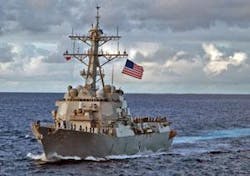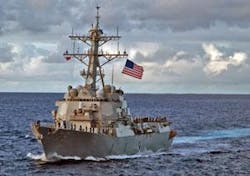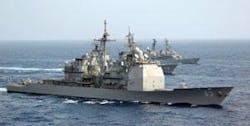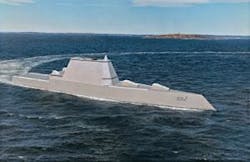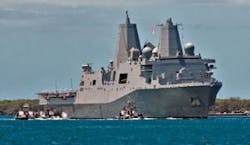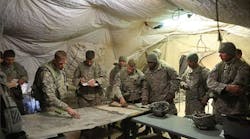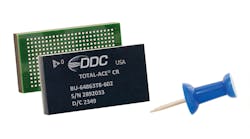Program managers go all-out on open systems and COTS to upgrade existing destroyers, cruisers, and other surface warships, while looking ahead to new destroyer and cruiser electronics and electro-optics technologies.
By Edward J. Walsh
In October 2007, Chief of Naval Operations Adm. Gary Roughead joined Marine Corps commandant Gen. James Conway and Adm. Thad Allen, commandant of the U.S. Coast Guard, to issue an unprecedented joint maritime strategy that stresses the integration of seapower with overall U.S. military strength.
The three sea service chiefs said that the new strategy “binds our services more closely together than they have ever been before,” adding that “the Sea Services will establish a persistent global presence using distributed forces that are organized by mission and comprised of integrated Navy, Marine Corps, and Coast Guard capabilities... To be effective, there must be a significantly increased commitment to advance maritime domain awareness (MDA) and expand intelligence, surveillance, and reconnaissance (ISR) capability and capacity.”
Also in October, Roughead and Conway released a set of fiscal year 2008 objectives to support the new strategy, including making theater ballistic missile defense and maritime domain awareness operational.
These policy announcements followed Navy Secretary Donald Winter’s statement to the House Armed Services Committee in March of last year that the Navy will pursue “an aggressive investment strategy to build an affordable 313-ship fleet.” The Navy established the 313-ship target in early 2006 and reaffirmed it in February 2007 in its six-year shipbuilding plan for 2008 through 2013.
The Navy achieved considerable progress in building joint Naval warfighting capability by inserting Navy Open Architecture (OA) standards for surface ships, aircraft, and submarines, and the start last month of a modernization program for the seven oldest Ticonderoga-class (CG-47) cruisers that brings them into open-architecture compliance. The cruiser program will dovetail with a broader Aegis modernization for the 15 remaining cruisers and 62 Arleigh Burke-class (DDG-51) destroyers, set to start in 2012—the Navy’s most ambitious surface warship initiatives in years.
The Navy met modest success in its efforts to enhance U.S. seapower in 2007. On 29 Sept., President Bush signed the 2007 defense appropriations bill, providing $9 billion for construction of eight ships, meeting the Navy’s full request.
On 13 Nov., the president signed the 2008 bill, which contains $13.7 billion for five new Navy ships: a Virginia-class (SSN-774) attack submarine and a Zumwalt-class (DDG-1000) destroyer, one CVN-21 aircraft carrier, one San Antonio-class (LPD-17) amphibious assault ship (amphib), and one new LHA-6-class amphib. The bill adds long-lead funds for an additional Virginia-class SSN, another San Antonio-class amphib, and three Lewis & Clark-class cargo ships.
Despite continuing concerns about serious coast overruns on the Coast Guard’s Deepwater program, Coast Guard commandant Allen in September said that the Coast Guard’s new National Security Cutter, built by Northrop Grumman Ship Systems teamed with Lockheed Martin, was “the best first-in-class cutter ever built” for the service, adding that the Coast Guard was working to address the cost problems. The Bertholf (WMSL-750), the first of eight NSCs planned, completed at-sea machinery trials in December.
On 18 Oct., the Pascagoula, Miss., shipyard of Northrop Grumman Ship Systems began fabrication work for the Arleigh Burke-class guided-missile destroyer William P. Lawrence (DDG-110), the 60th ship of the planned class of 62 Burkes to be fitted with the Aegis combat system. Kidd (DDG-100) was commissioned June 9 in Galveston, Texas.
Northrop Grumman continued construction of the San Antonio class, with the keel-laying for San Diego (LPD-22) in May and Anchorage (LPD-23) in September. Mesa Verde (LPD-19) commissioned in Panama City, Fla., on December 15. Also in December, the company launched New York (LPD-21) at its Avondale, La., shipyard, with delivery to the Navy scheduled in 2009. Green Bay (LPD-20) will go through sea trials in 2008. The first two ships of the class, San Antonio and New Orleans (LPD-18), already are in service.
Northrop Grumman also won a contract for detail design and construction for LHA-6 in a program called the Amphibious Assault Ship Replacement Program or LHA-R. The new amphib is intended as a variant of the eighth Wasp-class big-deck amphib, but won’t have a welldeck. The first of the new class is planned for delivery in 2012.
Navy officials expect future ship design to benefit from the open-architecture program, which started in the mid-1990s for surface-ship combat systems and aims at transforming ship computing systems by mandating commercial standards.
Open architecture a top priority
Nick Guertin, Deputy Director of Open Architecture in the Program Executive Office for Integrated Warfare Systems (PEO IWS), explained in December that the Chief of Naval Operations and the Assistant Secretary of the Navy for Research, Development, and Acquisition define OA as “the confluence of business and technical practices yielding modular, interoperable systems that adhere to open standards with published interfaces.”
In August 2004, then-ASN (RDA) John Young established an Open Architecture Enterprise Team made up of officials from the surface, aviation, and undersea communities, as well as C4I and Marine Corps organizations to “collectively oversee the development and implementation of enterprise-wise OA processes, business strategies, and technical solutions.”
Guertin stressed that while OA leads to technical benefits, it’s not aimed specifically at technical problems. He said that “while we are touting technical aspects such as building modular systems, interoperability and secure information exchange, the open-architecture business practices represent the biggest cultural and strategic shifts in organizational behavior.”
In December 2007, PEO IWS announced the release of version 1.1 of the Naval Open Architecture Contract Guidebook. Guertin said that the guidebook represents a compilation of best practices and lessons learned in contracting for open-architecture systems in a digestible, easy-to-use format.
The guidebook includes information on special contract requirements, recommended data language for code headers, guidance on the use of open-source software, recommendations on system-specification languages, and other key data for use by contractors in bidding on new procurements for which open-architecture compliance is a requirement.
Guertin says that the open-architecture program is developing a Software Hardware Asset Reuse Enterprise (SHARE), a central repository for software for which the Navy has acquired “government purpose rights”—intellectual property rights that the Navy can acquire for systems it purchases from contractors. Navy programs could deposit software in the SHARE for future use by other programs, which could access the repository to obtain needed software.
He says that the arrangement allows the Navy to avoid being locked into using only one company to build or upgrade systems, because other companies can see how those systems work.
The Navy’s Ship Self-Defense System (SSDS Mk 2) program, developed by Raytheon, already is open-architecture compliant. The system uses Ada, C, and C++ languages in multiple ship defense systems aboard aircraft carriers and larger amphibious ships.
In September 2007, LynuxWorks Inc. in San Jose, Calif., announced that its real-time operating system LynxOS has been adopted by Raytheon to support the SSDS open-architecture environment. The company says that LynxOS also has been integrated with DDG-1000, the Aegis combat system, and the Tomahawk cruise missile, which also are required to meet open-architecture standards.
SSDS Mk 2 also has incorporated a new multilanguage compiler, called GNAT Pro and developed by AdaCore Inc., to support LynxOS and Ada language applications.
The DDG-1000 remains the Navy’s frontline shipbuilding program. The Navy is using a unique acquisition strategy for DDG-1000, based on four prime contractors: shipbuilders Northrop Grumman Ship Systems and General Dynamics’ Bath Iron Works; Raytheon’s Integrated Defense Systems business unit, as combat systems integrator; and BAE Systems, prime for the advanced gun system.
In November the Navy awarded contracts to Northrop Grumman ($90 million) and Bath ($141.9 million) for additional long-lead material and pre-production planning in support of detail design and construction for the first two ships. Bath will build the DDG-1000 hull. Northrop Grumman will build the DDG-1001 hull and the deckhouses for both ships at its composite-specialty shipyard in Gulfport, Miss.
The first of the lead ships is scheduled for delivery in 2012. Following delivery and sea trials, the Navy will decide how to allocate the work between the two yards on the rest of the class, currently planned at eight ships.
Raytheon has developed an OA-compliant DDG-1000 Total Ship Computing Environment Infrastructure (TSCEI) that links ship systems through a distributed network, allowing overall ship control.
Stuart Karon, Raytheon’s DDG-1000 business development lead, explains that the DDG-1000 mission center workstations and displays will enable bridge watchstanders to control all ship systems, including weapons, sensors, communications, and ship machinery. The high degree of automation will permit the DDG-1000 to go to sea with a crew of only 148 personnel (the newest Aegis destroyers require a 276-man crew).
Karon says that the Navy has certified the company’s first three TSCEI software releases, with release 4 in testing and a fifth release in development. To encourage “openness,” he says, the company donated to the Navy at no cost an early version of the DDG-1000 SHARE database, allowing smaller technology companies to review the program requirements.
The mission center will use new OA-compliant common enterprise display system (CEDS) consoles, which are being developed by General Dynamics Advanced Information Systems and DRS C3 Systems.
In November 2007, the Naval Sea Systems Command awarded indefinite delivery/indefinite quantity contracts for Phase 2 CEDS development, qualification, production, and support, with the GDAIS award valued at $83 million and DRS C3 at $62.6 million award, depending on the number of units ordered.
In February 2007, Raytheon and IBM announced a teaming arrangement to use IBM’s blade servers and WebSphere software for the TSCEI, running on custom Real-Time Linux. IBM says that the technology insertion will expand the TSCEI’s ability to accept Navy open-architecture applications that potentially will reduce costs and development risks and ensure ease of upgrade with future OA-compliant products, while meeting Navy requirements for reliability and time-critical response for combat systems.
The IBM servers will be housed in 16 electronic modular enclosures, each in the range of eight by 20 feet and protected by shock-insulated flooring and bulkheads.
The TSCEI has incorporated a data-distribution service developed by Real-Time Innovations Inc., an OA-compliant middleware layer that provides high throughput and low- latency messaging between shipboard applications.
The DDG-1000 class will introduce several weapon and sensor systems, including an advanced 155-millimeter gun system for long-range fires and a Mk 57 peripheral vertical launch system, both built by BAE Systems. The automated AGS is loaded, aimed, and fired without a crew. The Mk 57 is designed to accommodate all Navy ship-launched missiles.
Raytheon is prime contractor for the dual-band radar (DBR) for air defense and the integrated undersea warfare system (IUSW). The DBR integrates a Raytheon-developed SPY-3 X-band multi-function radar and an S-band volume-search radar provided by Lockheed Martin Maritime Systems and Sensors (MS2). Raytheon is providing the passive sonar component of the IUSW and Lockheed Martin the active component.
In December, a new electro-optical/infrared system developed by Raytheon for the DDG-1000 went through a successful design review, authorizing start of production of the system. The EO/IR system provides 360-degree situational awareness, mine-like object detection, and guidance for ship self-defense guns.
The DDG-1000 also introduces an integrated power system based on a zonal electrical arrangement that distributes power from a single set of generators to both propulsion and ship systems. Originally, DRS Technologies was scheduled to provide a high-torque permanent magnet motor for the first two ships, but when the motor failed in testing in 2006 the Navy selected instead a more conventional advanced induction motor built by Converteam, formerly Alstom. The Converteam motor is in service on the Royal Navy’s Type 45 destroyers.
To minimize radar cross-section and maximize stealth, the ship will be built to a “tumblehome” design that features a hull that slopes outward to the waterline. Program officials say that extensive model-testing up to hurricane-level sea state 9 has proved out the stability of the design.
The Zumwalt program remains controversial because of cost concerns associated with design, construction, and systems integration for a ship that, at a planned displacement of 14,500 tons, will be significantly larger than the Navy’s Ticonderoga-class cruisers.
The Zumwalt class is the most prominent of the Navy’s new family of advanced surface ships that also includes a 55-ship class of 3,000-ton littoral combat ships and a future cruiser (CGX). Some Navy and industry officials suggest that the Navy will not build the planned eight DDGs, but instead will use the first two ships as test beds for technologies to be adapted for the cruiser or other surface programs.
Two industry teams, one led by Lockheed Martin MS2 and Marinette Marine shipyard, and the other by General Dynamics, Bath, and Austal US each were awarded construction contracts for two LCSs. In April 2007, the Navy canceled LCS-3, which was to be built by the Lockheed Martin-Marinette Marine team, because of cost concerns.
In late June, then-ASN(RDA) Dolores Etter announced a major realignment of Navy surface ship acquisition management, called Team Ships, aimed at improving oversight for shipbuilding and the engineering and systems-integration processes for shipboard weapon, sensor, communication, and other systems.
In November, the Navy terminated the General Dynamics contract for LCS 4, again because of cost and contract difficulties. However, CNO Adm. Roughead and Navy Secretary Winter both said they remain committed to the LCS program.
General Dynamics has announced it has designed a shallow-draft, high-speed multimission variant of its LCS, capable of air, surface, and undersea defense, that it is offering to international navies.
The first LCS will deliver in 2008. Navy officials say that the CGX concept has gone through an analysis of alternatives, which is still being evaluated, on potential ways for meeting future air- and missile-defense gaps.
Cruiser modernization work started last month aboard Bunker Hill (CG-52) on the ship’s machinery, the Aegis weapon system, and weapons and sensors. The effort will extend to all seven “baseline 2” cruisers, Bunker Hill through Philippine Sea (CG-58). The wider Aegis modernization program will encompass the remaining cruisers, Princeton (CG-59) through Port Royal (CG-73) and all 62 Burkes (DDG-51 through DDG-112).
The cruiser modernization should be finished by 2016; Aegis modernization starts with the Arleigh Burke in 2012 and won’t be finished for all the destroyers until 2031.
The Navy started upgrading the cruisers in the late 1990s through its “SmartShip” program, conceived as a comprehensive replacement of hull, mechanical, and electrical (HM&E) systems aimed at achieving dramatic reductions in ship manning needs. The program was reorganized as “cruiser conversion,” adding an area air-defense capability, new versions of the SQQ-89(v) undersea defense system, the cooperative engagement capability (CEC), and the infrastructure needed for theater ballistic defense.
In March 2006, the Navy awarded Lockheed Martin MS2, longtime prime contractor for the Aegis system, a $20.8 million contract for the first Aegis combat system shipset for the CG modernization. Other members of the Lockheed Martin team are Computer Sciences Corp., a longtime partner on Aegis; Advanced Sciences & Technologies (AS&T); Basic Commerce & Industries Inc.; Chariot; DRS Technologies; Keystone; Northrop Grumman; Technology Services Corp.; and Real-Time Innovations Inc.
Installation of new combat system displays, consoles, and other components will start during the machinery work and continue until August 2008, when the new systems are scheduled to start testing. The ship will be returned to the Navy in early 2009.
Orlando Carvalho, vice president and general manager for sea-based missile defense for Lockheed Martin, says that the combat system modernization uses a “build a little, test a little” approach the company has long employed to upgrade Aegis hardware and software for the seven fielded Aegis system baselines.
Carvalho says that “the Ticonderoga deployed in 1983 with baseline 0-plus, residing on Navy-proprietary MIL-SPEC computers. Today the Arleigh Burkes are being commissioned with baseline 7, and there were a number of upgrades within those seven generations.”
Transition to commercial off-the-shelf (COTS) hardware and software started in the 1990s with baseline 6. Carvalho says that the company introduced COTS in a two-step approach first by adding commercially developed software and later re-architecting the new software to support future upgrades.
Meanwhile, Carvalho says, the Navy needed new combat capability that required greater computing power, such as theater ballistic missile defense, the evolved Seasparrow air-defense and Standard SM-2 block 4 air-defense missiles, pulse Doppler radar upgrades to the Aegis SPY-1 phased-array air-defense radar for more effective performance in littoral waters.
Aegis system upgrades implemented aboard DDGs-79 through -90, called the Flight 2A ships, integrated COTS components with older Navy-proprietary technology, through use of adjunct processors that performed translation functions between the COTS processors and the older legacy computers. The company then moved to a full-scale COTS architecture, designated COTS refresh 0 (CR-0), for DDGs-91 through -102.
The final 10 ships of the Burke class, DDGs-103 through -112, add still more COTS components (CR-1). The cruiser modernization introduces CR-2, which will bring those ships into full Navy OA compliance.
The Aegis modernization for the DDGs and later cruisers will bring in a new CR-3 software refresh. Lockheed Martin now is working with the Navy to identify COTS products for CR#3.
The modernization program incorporates IBM blade server technology to support the open computing environment running C++, Java, and other commercial languages. The architecture uses a layer of middleware as an interface for commercial processing and Navy real-time applications, such as air defense.
Lockheed Martin will use Concurrent Corp.’s RedHawk Linux operating system and NightStar software development tools which, Lockheed Martin says, will be OA-compliant and provide the critical real-time functionality required for combat operations. Concurrent is teamed with Real-Time Innovations to provide Lockheed Martin with the Real-Time Innovations data distribution middleware and RedHawk Linux.
Lockheed Martin also has selected InterMAPhics display rendering software developed by Gallium Visual Systems Inc., a unit of Kongsberg Defence & Aerospace, for OA-compliant enhancements to the Aegis displays.
Carvalho says that a critical challenge to introducing COTS for Aegis always has been the requirement to maintain the real-time performance needed to engage approaching high-speed anti-ship missiles. System performance, he says, must be “deterministic”—capable of responding identically every time.
Carvalho says that commercially developed hardware and software only now are capable of the performance required for Navy combat systems, which was provided for many years by military-unique shipboard UYK-7, -43, and -44 computers.
Jim Sheridan, director of Aegis U.S. Navy programs at Lockheed Martin, says that the combat systems modernization for the cruisers starts with replacement of the obsolescent displays and computer hardware and software with new COTS-based UYQ-70 display consoles, and a new OA-compliant computing infrastructure that will host new programs for the Aegis weapon system, radar control, and display control.
The cruisers will get a new SPQ-9B, the primary radar for the ship’s gun weapon system that also will act as a queuing system for the SPY-1 radar. The Phalanx terminal defense gun mount will get a Block 9B upgrade, providing an anti-surface capability.
The ship’s 54-caliber deck gun is replaced with a .62-caliber gun, enabling it to fire the Navy’s new extended-range guided munitions. The Mk 41 vertical launch system is upgraded to launch the Evolved Seasparrow air-defense missile.
The Aegis modernization includes the SM-6 long-range air-defense missile and the naval integrated fire-control-counter-air (NIFC-CA) capability, a program that will integrate weapons and sensors for long-range air defense
The destroyers only will get an open-architecture version of the Navy’s theater ballistic missile defense (TBMD) capability. The Navy is looking at the possibility of adding funds for the TBMD upgrade for the CGs in its 2010 budget submission.
The effort adds the SQQ-89A(v)15 anti-submarine warfare system, which includes a multifunction towed-array sonar that detects acoustic returns to the active emissions of the ship’s hull-mounted SQS-53 sonar for detection of quieter threats, such as diesel submarines.
Aegis modernization also will include the upgrades going to the baseline 2 cruisers in the cruiser modernization program. The enhancements that are achievable with software modifications and don’t require equipment upgrades also will be backfit to the baseline 2 ships.
COTS upgrades for all Navy ships centers around the Navy’s standard shipboard display processor, the UYQ-70, which is purchased from a team led by Lockheed Martin through a standing Navy UYQ-70 contract. The Navy first ordered early versions of the ’Q-70 in February 1994, the team, which includes DRS Technologies and Barco, has delivered more than 6,000 units, with 8,000 projected by 2010.
Lee Meyer, Lockheed Martin’s director of enterprise solutions and products, says the system now is offered in 40 separate versions that can be built from more than 900 features. Customers mix and match features, such as operating systems and processor types, to build the system needed to meet their requirements for storage, interfaces, display, and integration within cabinets aboard surface ships or submarines. The ’Q-70 is a key element of the Navy’s acoustic rapid COTS insertion program introduced for the Virginia-class attack submarine to quickly field new processor technology. The ’Q-70 also is going aboard the Hawkeye 2000 upgrade to the Navy’s E-2 Hawkeye maritime surveillance aircraft.
Meyers says that the UYQ-70 supports the Navy’s OA team in determining the COTS components of future open-architecture phases. Surface-ship upgrades generally are set every four or five years, while submarine systems require upgrades every two years. The Aegis cruisers and destroyers, as they go through their modernization programs, will get new ’Q-70s.
The ’Q-70 also has moved from combat systems management to command and control. In December, the Navy ordered 142 units, an award valued at about $24 million, for the PEO for Command, Control, Communications, Computers, and Intelligence and Space (C4I & Space), and the Networks, Information Assurance, and Enterprise Services Program Office for its Integrated Shipboard Network System for shipboard C4I support.
